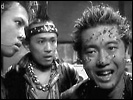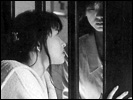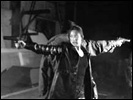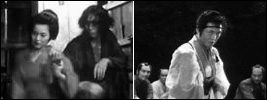 |
 |
|
Battle Heater
Door III
Gun Crazy: A Woman from Nowhere
Roningai
Village of Doom
|
 |
Battle Heater
Original Title: Battle Heater
Director: Joji IIDA
Cast: Pappara KAWAI, Akira EMOTO, Goro KISHITANI, Shigeru MUROI
Year: 1989
Running time: 93 mins.
 When a lovestruck, dirt-poor lodger at a squalid boarding house finds himself a free kotatsu heater on the scrap heap, he can hardly believe his luck. But things rapidly spiral out of control when he awakens the age-old demon that had been trapped inside the apparatus and which is hungry for human souls. When a lovestruck, dirt-poor lodger at a squalid boarding house finds himself a free kotatsu heater on the scrap heap, he can hardly believe his luck. But things rapidly spiral out of control when he awakens the age-old demon that had been trapped inside the apparatus and which is hungry for human souls.
The mutant offspring of a Saturday Night Live sketch and a Twilight Zone episode, this early film by Iida, who would later find fame with the TV series Night Head, is a piece of in-your-face slapstick in the less than subtle tradition of Takeshi Kitano in Getting Any?, Takashi Miike in Naniwa Yukyoden and Yudai Yamaguchi in Battlefield Baseball (it would make a superb double bill with any of these).
Certainly, this can be dismissed as cheap silliness, but it can be most effective if you're in the right mood for it. Iida dares to go all the way, mining this to its full potential and never chickening out, in the best moments creating something akin to Roger Corman's original version of The Little Shop of Horrors. A few musical interludes (by the band Bakufu Slump, for the occasion headed by Goro Kishitani in his film debut) are the icing on a very creamy (or cheesy) cake.
[TM]
|
 |
Door III
Original Title: Door III
Director: Kiyoshi KUROSAWA
Cast: Minako TANAKA, Akihiro NAKAZAWA, Ryo AMAMIYA, Hatsunori HASEGAWA, Ren OSUGI, Taro SUWA
Year: 1996
Running time: 89 mins.
 The year 1996 was a transitional year for Kiyoshi Kurosawa, during which he moved from the realms of V-cinema into the position he holds today, that of the respected auteur who bends genres into entirely new shapes. This transition is most clearly apparent in his six-part series of Sho Aikawa crime comedies Suit Yourself of Shoot Yourself!, which he made between 95 and 96 and which show a gradual but noticeable progression in terms of style and themes towards his renaissance film Cure. The year 1996 was a transitional year for Kiyoshi Kurosawa, during which he moved from the realms of V-cinema into the position he holds today, that of the respected auteur who bends genres into entirely new shapes. This transition is most clearly apparent in his six-part series of Sho Aikawa crime comedies Suit Yourself of Shoot Yourself!, which he made between 95 and 96 and which show a gradual but noticeable progression in terms of style and themes towards his renaissance film Cure.
Door III, released in 1996, right in between the above six films, also carries this transitional character. An only loosely related follow-up to Banmei Takahashi's first two entries in the Door series, it has a suitably schlocky premise (a vampiric parasite infests women and makes them slaves to an enigmatic millionaire), but an execution that shows a filmmaker experimenting with the possibilities of the genre in the hopes of finding a way to use it for his own more ambitious purposes.
Miyako works as a door-to-door saleswoman of insurance policies. When she meets the handsome young owner of a small firm, she is instantly attracted to him. But the more she gets to know him, the stranger he and his all-female staff begin to behave. As the man intensifies his advances, Miyako finds herself the target of nighttime assaults by the possessed, ghostly office ladies.
Working from a script by his then regular collaborator Chiaki Konaka (Serial Experiments Lain, Malice@Doll), Kurosawa clearly has a tremendous time citing from the rich annals of horror film history (Cronenberg's Shivers, Hooper's The Texas Chainsaw Massacre, Siegel's Invasion of the Body Snatchers) and comes up with scenes he would restage almost shot-for-shot in his later films; the attack of one possessed female will look very familiar to anyone who has seen Pulse. Pleasant enough when taken purely as a low budget horror flick, Door III becomes a highly intriguing curio when seen in the context of Kurosawa's body of work.
[TM]
|
 |
Gun Crazy: A Woman from Nowhere
Original Title: Gun Crazy: Fukushu No Koya
Director: Atsushi MUROGA
Cast: Ryoko YONEKURA, Shun SUGATA, Shingo TSURUMI, Takeshi YAMATO, Takashi UKAJI, Bob SUZUKI
Year: 2002
Running time: 65 mins.
 Lethal ladies were a fixture of Japanese exploitation cinema of the 1970s, as epitomised by the delectable Meiko Kaji in her two most famous roles: Female Convict Scorpion and Lady Snowblood. Dormant during the 80s, like quite a few genres of popular cinema from the 70s it re-emerged another decade later with the birth of V-cinema. Particularly since Luc Besson's La Femme Nikita and its various remakes and spin-offs found global success, girls with guns have become a stalwart of Japan's straight-to-video industry. In addition to the low-budget revival of Female Convict Scorpion, there is the Zero Woman series, Prisoner Maria, Metropolitan Police Unit 82 and more recently Atsushi Muroga's Gun Crazy. Lethal ladies were a fixture of Japanese exploitation cinema of the 1970s, as epitomised by the delectable Meiko Kaji in her two most famous roles: Female Convict Scorpion and Lady Snowblood. Dormant during the 80s, like quite a few genres of popular cinema from the 70s it re-emerged another decade later with the birth of V-cinema. Particularly since Luc Besson's La Femme Nikita and its various remakes and spin-offs found global success, girls with guns have become a stalwart of Japan's straight-to-video industry. In addition to the low-budget revival of Female Convict Scorpion, there is the Zero Woman series, Prisoner Maria, Metropolitan Police Unit 82 and more recently Atsushi Muroga's Gun Crazy.
That Muroga isn't the most inventive or even talented of Japanese filmmakers should be well known to anyone who has seen the derivative Score or the impoverished Junk. In this first instalment in the Gun Crazy series he does a variation on the spaghetti western blueprint of the man, or in this case woman, with no name wandering into a dusty town to settle a few scores. Nothing wrong with that in itself, and he had the good sense to set his film in the otherworldly scenery of Okinawa, but Muroga fills it with insipid gun fights in which all the bullets hit the ground instead of their target and wastes a group of more than decent actors by having them ham it up beyond belief. This is the kind of cast that directors like Junji Sakamoto and Takashi Miike can work miracles with, but in Muroga's hands their performances hardly better those of the typically talentless foreigners that play opposite them and who were probably cast at a Naha branch of KFC.
The script occasionally makes interesting use of the tension between the US military presence and the local population of Okinawa, and Yonekura looks quite fetching in leather, but you know you're in trouble with a director who still thinks doing action scenes with people jumping through the air while firing two guns at once is a good idea in this day and age.
[TM]
|
 |
Roningai
Original Title: Roningai
Alternative title: Street of the Samurai
Director: Kazuo KUROKI
Cast: Yoshio HARADA, Shintaro KATSU, Kunie TANAKA, Kaori MOMOI, Renji ISHIBASHI
Year: 1990
Running time: 117 mins.
 In 1974 director Kazuo Kuroki made The Assassination of Ryoma, based on the life of the famed but doomed modernist hero from the end of the Tokugawa era. Roningai, made sixteen years later with the same lead actor, looks at the period leading up to the shogunate's downfall, portraying the social turmoil that brought a three-century power structure to its knees. In 1974 director Kazuo Kuroki made The Assassination of Ryoma, based on the life of the famed but doomed modernist hero from the end of the Tokugawa era. Roningai, made sixteen years later with the same lead actor, looks at the period leading up to the shogunate's downfall, portraying the social turmoil that brought a three-century power structure to its knees.
Focusing on a group of washed-up samurai that congregate drunkenly around a small town inn, Roningai portrays a society where the supposed upper strata of society has become dependent on the, officially low-ranking, merchant class, leading to weakening governmental power. All lamenting the loss of their privileges, they drink away the sorrow and beg freebies from the village prostitutes. When these ladies of the night start turning up murdered at the hands of a government militia that wishes to reverse the social degradation by eliminating what they see as it excesses, the small group of former swordfighters are faced with a choice: do they persist in their wish to rejoin a now morally corrupt system or will they protect the innocent from being slaughtered by it? Or will they choose the third, and easiest, option: to do nothing at all and continue draining the bar?
Kuroki's style is sparse, with long takes and few cuts, but never lacks dynamism thanks to a more than impressive cast who are given all the freedom they need by the director's restrained visual approach. Katsu, in his final screen performance, is perfectly suited to his role with his bulky body and bloated face and the flamboyant Harada is every bit his equal as his permanently intoxicated companion. The drama is slow to unfold, but the period setting, like the performances, is a vivid one.
A remake of the original 1928/29 three-parter by Masahiro Makino (and dedicated to his cinema pioneer father Shozo), which Makino himself already remade twice before, in 1951 as Yoidore Hachimanki, and in 1957, also as Roningai.
[TM]
|
 |
Village of Doom
Original Title: Ushimitsu No Mura
Director: Noboru TANAKA
Cast: Masato FURUOYA, Misako TANAKA, Shino IKENAMI, Izumi HARA, Renji ISHIBASHI, Beat Kiyoshi
Year: 1983
Running time: 106 mins.
 A talking point film upon its release due to its very violent finale, Village of Doom is a rare "straight" outing from former Nikkatsu Roman Porno figurehead Tanaka, who directed this film for Shochiku. Tsugio, a naïve and studious small town youth, sees his dream of becoming a soldier on the Manchurian front fall apart when the army doctor diagnoses him with tuberculosis. Still living with his grandmother, he loses his virginity to one of the village women whose husbands were shipped off to war. A talking point film upon its release due to its very violent finale, Village of Doom is a rare "straight" outing from former Nikkatsu Roman Porno figurehead Tanaka, who directed this film for Shochiku. Tsugio, a naïve and studious small town youth, sees his dream of becoming a soldier on the Manchurian front fall apart when the army doctor diagnoses him with tuberculosis. Still living with his grandmother, he loses his virginity to one of the village women whose husbands were shipped off to war.
However, the true object of his affections is his pretty cousin Yasuyo, who also feels for him, but can't return the sentiments for obvious reasons. When she is married off to a total stranger, and the town vigilante squad begin to eye Tsugio for his nightly trips to his lonely neighbour, the pressures of this microcosm begin to bear down on the sickly boy. When he buys a rifle to defend himself and uses it against his neighbour's recently returned husband, things quickly spiral out of control.
Village of Doom does indeed pack quite a punch and not merely for its very bloody climax. Although it lacks the incisive allegorical weight of Yasuzo Masumura's indictments of Showa-era militarism in such films as Hoodlum Soldier and Seisaku's Wife, Tanaka's familiarity with portraying man's more basic instincts here aids immensely in getting the stifling atmosphere of the one-dog town across.
Despite being set in a different age, as a portrait of the catastrophic results of social pressure upon the young, Village of Doom makes for an intriguing companion piece to Sogo Ishii's Panic High School. Adapted from the novel by Nozomi Nishimura, which was in turn based on a true story.
[TM] |